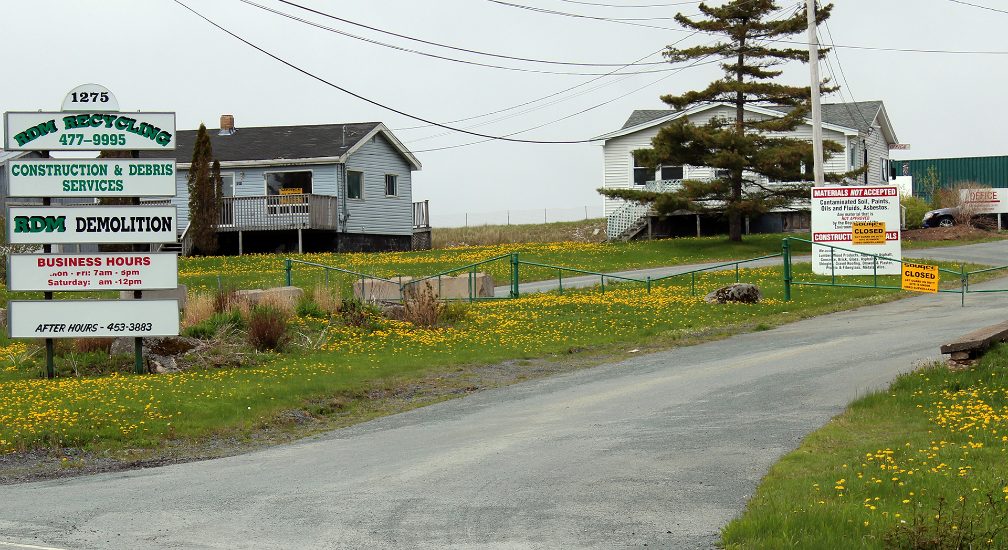KJIPUKTUK (Halifax) – After nearly eight years, the legal battles involving a contaminated recycling site in Harrietsfield have come to a close.
But nearby residents are not celebrating yet. The companies responsible for the pollution have stopped court-mandated water monitoring, and residents are still waiting for water treatment systems that the province promised would be in place by February.
Marlene Brown, a Harrietsfield resident of more than 30 years, lives just down the road from the waste site that has contaminated her community’s water supply. Watch her describe some of the daily difficulties she faces at home due to the polluted water coming from her well. Video by Rebecca Hussman, 2015
On March 9 Justice Gabriel of the Nova Scotia Supreme Court dismissed an appeal filed by two of the owners and operators of the RDM Recycling site, finding that the terms of the ministerial order issued to them by Environment minister Margaret Miller in 2016 to be reasonable.
The order requires that the owners of the company, 3076525 Nova Scotia Ltd. (307 NSL), conduct water testing and ongoing monitoring of wells flagged for having various parameters exceeding the Canadian drinking water guidelines, as well as pay for remediation of the site.
A similar appeal after the department of Environment issued an order against the companies was dismissed by the Nova Scotia Supreme Court in November 2016.
Three Harrietsfield residents, Marlene Brown, Melissa King and Angela Zwicker, were granted intervenor status in both appeals, and were represented by Ecojustice lawyers Kaitlyn Mitchell and Julia Croome for both hearings. They are among the Harrietsfield residents whose well water have been severely impacted by the runoff coming from the contaminated site.
According to Mitchell, during 307 NSL’s appeal the residents argued that “it was reasonable for the minister to hold responsible two directors of the company that owns the site and used to operate the RDM facility.”
“In upholding the Ministerial Order against 307 (NSL), Justice Gabriel acknowledged the serious impacts that contamination from the site has had on the environment and local residents, and that 307’s operations contributed to those impacts.”
“We’ve been disappointed so many times”

One of the intervenors, Marlene Brown, says she is grateful for Justice Gabriel’s decision to uphold the order, but she she remains cautiously optimistic about how things will play out now that the legal battles are over.
Brown and others living in the community have been voicing their concerns to city councillors, MLAs and the Department of Environment regarding the deteriorating water quality and subsequent health concerns for decades.
“I’m just fed up with it,” Brown says. “Once I see action happening, then I’ll be happy, but we’ve been disappointed so many times, with all levels of government.”
“In our own community here, every moment of every day is consumed with the contaminated water, either when you go to have a shower, brush your teeth, whatever… It’s always there in the back of your mind, and it’s very frustrating”
Brown says that it is hard for Nova Scotia Environment to understand what it is like for those who are stuck living with a contaminated water supply.
“In our own community here, every moment of every day is consumed with the contaminated water, either when you go to have a shower, brush your teeth, whatever… It’s always there in the back of your mind, and it’s very frustrating,” she says.
According to court records, the contamination was caused by a combination of things which took place over a number of years. Notably, before 307 NSL bought RDM and began leasing the property, 301 NSL was stockpiling 120,000 tonnes of non-recycling waste on site. Having these materials exposed to the elements resulted in chemicals seeping into the ground and then into the neighbourhood’s groundwater supply in a growing cloud, or plume.
After the department found out about this 301 NSL was ordered to put the waste in a containment cell designed to help catch the leachate, or run-off, from the materials; however, court files indicate that the containment cell was not properly built. Hence the contamination was caused by the illegal stockpiling of the waste materials (and the subsequent leaching of these materials via the ineffective containment cell) as well as the continued operations on site by the owners of 307 NSL, from 2005 until being forced to shut down in Jan. 2013.
“Residents health are at risk because of this plume, and I’d like to see some action,” Brown says.
Still waiting for water treatment system
In Nov. 2016, Environment minister Miller said that the province would be providing water treatment systems for eight of the Harrietsfield homes listed in the ministerial orders, and that they would be installed in Feb. 2017. However, that has yet to happen.
When asked about this, Krista Higdon, media relations adviser for the department, said in an email that “staff are going through the procurement process reviewing the proposals. Once a decision is made on a successful company, affected residents will be notified.”
Brown says that two of those eight homes listed in the order and that are supposed to receive treatment systems are currently unoccupied.
“I’d like to see them take those water systems and actually give them to other people who are even closer than we are to the site,” she says, expressing concern for her neighbours who also live downgradient from the RDM site, which is on a hill.
“Those other homes have similar water results as we do down here. So they need to do their homework,” she says. “If they care enough about people and the environment, they will do their research and rectify what’s been going on.”
Brown also does not have high hopes for the companies who are required to begin cleaning up the site, now that their appeal has been dismissed.
“I think they’re going to drag on. I don’t see anything happening on the site for at least another year. Maybe longer,” she says. “In 2010 they were given the first ministerial order. They didn’t comply with it, and the Nova Scotia Environment did not enforce it. So what’s going to make things change immediately because of this?”
“We have no idea what’s in the water now”
Melissa King agrees, adding that to her, it feels like the companies “don’t recognize their responsibility.”
“They appealed the first order, they lost, but there was an opportunity to appeal again, so they appealed again,” King says. “They don’t have another opportunity to do that now, but it seems that they’ll take any way out or any way to delay that they can think of, no matter what it costs.”
Brown also notes that 307 NSL stopped the water monitoring of wells with levels of contaminants which exceeded national drinking water guidelines, including hers, as the terms of ministerial order require.
“We have no idea what’s in the water now,” she says.
“The fact that they cut off the water monitoring program for the past 15 months shows me just how much they are concerned with the health and well being of the residents and our environment.”
Brown adds that she, King and Zwicker want to make public the fact that RDM is a contaminated site.
“We want them to make that public because we have new homes going up within 500 metres of the site, and these new residents have no idea of what’s in their neighbourhood,” she says.
Robert Grant, the lawyer who represented the owners of 307 NSL during the latest appeal, said his clients decline the opportunity to comment.
If you can, please support the Nova Scotia Advocate so that we can continue to pay writers like Rebecca to cover issues such as poverty, racism, exclusion, workers’ rights and the environment in Nova Scotia. A pay wall is not an option, since it would exclude many readers who don’t have any disposable income at all. We rely entirely on one-time donations and a group of 25 or so dedicated monthly sustainers.




keep going hunny i hope someone listens amen
Best of Luck and hopes that someone will soon pick up the ball and get it rolling